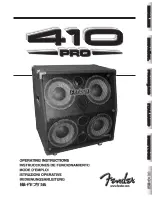
6. Technical specifications
Single-channel amplifier for electric basses
Inputs (notes 1, 4)
input
High-impedance instrument input
Mono jack, ¼” (6.35 mm) Sensitivity: 22 mV (-33 dBV)
Impedance: 1 Megohm
Equivalent input noise: 2 µV (–114 dBV),
A-weighted
high / low switch: 10 dB attenuation
aux in
Stereo jack, ¼ “ (6.35 mm)
L + R mixed and added pre master,
but post tone controls.
Level control.
Sensitivity: 2 x 185 mV
Impedance: 22 k (each channel)
return
Return for parallel effects loop
Mono jack socket, ¼” (6.35 mm)
Sensitivity: 400 mV
Impedance: 10 k
Outputs (note 2)
headphones
Output voltage: 1.1 V (20 mV input)
Power: max. 100 mW into 32 ohms
Internal speaker is muted when headphone is plugged in.
Stereo jack, ¼” (6.35 mm)
For use with stereo headphones only.
Please do not connect anything with a mono jack plug.
line out
Switchable pre / post master
Mono jack, ¼” (6.35 mm)
Output voltage: 2.3 V
sub out
Subwoofer output without filter
Mono jack, ¼” (6.35 mm)
Output voltage: 2.3 V
send
Send for parallel effects loop
Mono jack, ¼” (6.35 mm)
Output voltage: 900 mV
tuner
Tuner output, not affected by mute
Mono jack, ¼” (6.35 mm)
Output voltage: 900 mV
DI out
Pre-master, switchable pre / post tone controls and
effects, level adjustable, balanced XLR output.
Output voltage: 0…370 mV
Insert points
insert pre eq
Insert loop before tone controls, but after compressor
Stereo jack, ¼” (6.35 mm)
Output voltage: 900 mV
tip = send, ring = return
insert post eq
Insert loop after tone controls
Stereo jack, ¼” (6.35 mm)
Output voltage: 900 mV
tip = send, ring = return
Footswitch connections
footswitch
Stereo jack, ¼” for dual footswitch
tip = footswitch for input muting
ring = footswitch for parallel effects loop on/off
sleeve = common (ground)
mute switch disabled when footswitch is plugged in
Tone controls
colour
–1 dB at 300 Hz, +8 dB at 3.7 kHz
bass
±8 dB at 80 Hz
bass boost
+10 dB at 55 Hz
middle
±15 dB at 200…2000 Hz (adjustable)
Bandwidth (switchable, note 3):
wide: 1.6 octaves (Q = 0.37)
narrow: 0.6 octaves (Q = 1)
treble
±12 dB at 6 kHz
tone balance
No effect if intensity is set fully to the left. The following
values apply if intensity is set fully to the right:
balance left:
+10 dB at 50 Hz
balance at center position:
+8 dB at 50 Hz, and +7 dB at 10 kHz
balance right:
-3 dB at 50 Hz and +8 dB at 10 kHz
(shelf-type frequency response in all cases)
hf level
+6/-19 dB at 10 kHz, effective on built-in
loudspeaker only.
Compressor (note 5)
threshold range
1 mV … 350 mV at instrument input
ratio range
1:1 … 10:1
Time constant
38 ms
Indicator LED
Lights up at approx. 1 dB gain reduction.
Power
Power amp
240 W / 8 ohms, discrete bipolar transistor design
Limiter threshold
220 W
Analog signal
processing
Subsonic filter, low distortion RMS limiter
Speaker system
12“ (300 mm) woofer with neodymium alloy magnet,
bass reflex enclosure
4” (100 mm) mid-high direct-radiating speaker
Mains power
Mains voltage (depending on model):
100, 120, 230, or 240 V AC, 50–60 Hz
Power consumption: max. 700 W
Mains fuse
5 x 20 mm
slow 3.15 A for 230 and 240 V models
slow 6.3 A for 100 and 120 V models
General
Cabinet
0.7“ (18 mm) birch plywood
Finish
waterbased acrylic, black spatter finish
Dimensions
500 mm (19.7 “) high
420 mm (16.5 “) wide
350 mm (13.8 “) deep
Weight
23,5 kg (51.7 lbs)
Notes:
1. Input sensitivities refer to 220 watts into 8 ohms at full gain and volume settings,
neutral tone control settings (hf level in center position, intensity in left position), and
1 kHz sine-wave test signal.
2. Output levels refer to 63 mV / 1 kHz at instrument input, unless stated otherwise.
3. Bandwidth of tone controls refers to one half of dB-gain at center frequency. For
example, if center gain is –15 dB, then bandwidth is the frequency band between the
–7.5 dB points.
4. Equivalent input noise voltage obtained by measuring noise voltage at speaker out-
put and dividing by the effective voltage gain of the amplifier. Full gain and volume
settings, neutral tone control settings, input shorted, frequency range 20 Hz – 20 kHz.
5. Compressor threshold refers to 1 dB gain reduction. Threshold tolerance ±3 dB. Ratio
refers to 20 dB gain reduction. Ratio varies with gain reduction due to soft-knee
compression.
Specifications and appearance subject to change without notice.


























